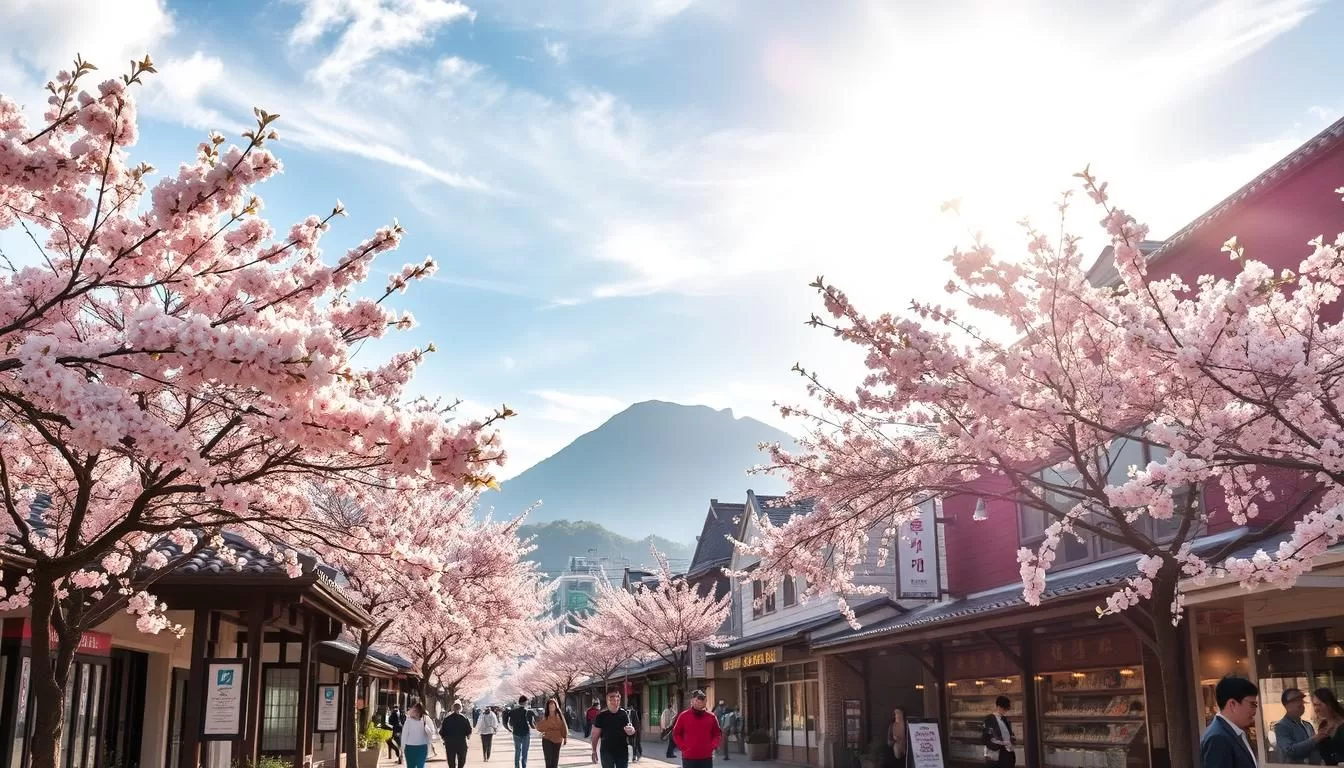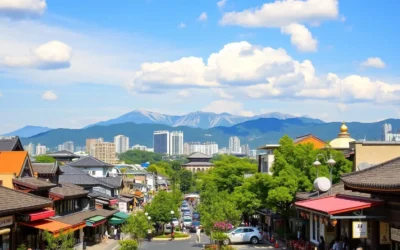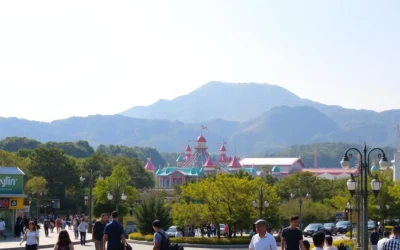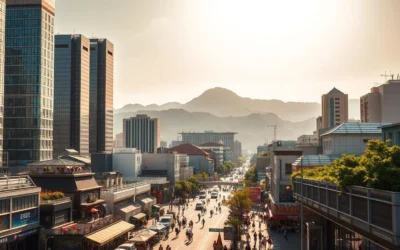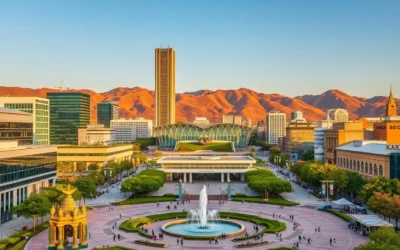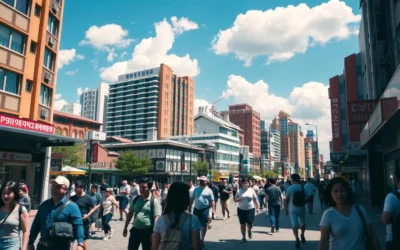Planning your trip around the right time of year can make all the difference. If you’re considering a visit to this vibrant region, understanding the weather patterns is key to a memorable experience.
Spring and autumn are widely regarded as the best time to explore. During these seasons, temperatures are mild, and the scenery is stunning. From mid-April to mid-June, daily averages range from 59 to 65 degrees F (15 to 18 degrees C), making it perfect for outdoor activities.
Autumn, from September to October, offers similar comfort with average daily temperatures between 66 to 70 degrees F (19 to 21 degrees C). These months also coincide with cultural festivals, adding an extra layer of excitement to your travel plans.
Whether you’re exploring bustling cities or serene landscapes, timing your visit during these months ensures you enjoy the region at its finest. Stay tuned for more tips on making the most of your trip!
Understanding Daegu’s Climate and Seasons
Understanding the climate of a region can greatly enhance your travel experience. This area experiences four distinct seasons, each offering unique weather patterns. From warm summers to chilly winters, knowing what to expect helps you plan better.
Overview of Seasonal Weather Patterns
Spring and autumn are the most pleasant times to visit. During spring, temperatures range from 59 to 65 degrees F (15 to 18 degrees C), with occasional rain on about 20% of days. Autumn brings similar comfort, with temperatures between 66 to 70 degrees F (19 to 21 degrees C) and fewer rainy days.
Summers can be hot and humid, with temperatures soaring up to 35 degrees C (95 degrees F) and humidity levels reaching 80%. Winters, on the other hand, are cold, with temperatures dropping to -5 degrees C (23 degrees F) and an average of 15 frost days.
How Weather Impacts Your Travel Plans
The climate directly affects your daily activities. Clear sky conditions in spring and autumn make them ideal for outdoor adventures. However, summer’s heat and humidity might limit your time outside, while winter’s chill encourages cozy indoor activities.
Wind speeds average 2.5 m/s, with stronger gusts in winter. This can influence activities like hiking or sightseeing. Rainfall peaks in July, accounting for 30% of the annual precipitation, so packing waterproof gear is essential.
“The weather is a powerful factor in shaping your travel experience. Knowing what to expect ensures you’re prepared for any condition.”
| Season | Temperature Range | Rainfall | Key Features |
|---|---|---|---|
| Spring | 59-65°F (15-18°C) | 20% rainy days | Mild, blooming scenery |
| Summer | 77-95°F (25-35°C) | High humidity | Hot, monsoon rains |
| Autumn | 66-70°F (19-21°C) | 15% rainy days | Crisp air, colorful foliage |
| Winter | 23-41°F (-5-5°C) | Frost days | Cold, snowy landscapes |
Exploring Daegu in Spring: Bloom and Mild Temperatures
Spring brings a burst of life and color to this vibrant region. With mild weather and blossoming trees, it’s no wonder this season is a favorite among travelers. The average temperature hovers around 59°F (15°C), creating a perfect balance of warm sunshine and a cool breeze.

Cherry Blossom Festivals and Natural Beauty
One of the highlights of spring is the stunning cherry blossom season. These delicate flowers typically reach their peak in early April, transforming parks and streets into a sea of pink and white. Popular spots like Apsan Park and Duryu Park see a 30% increase in visitors during this time.
Local festivals celebrate this natural wonder, offering a chance to immerse yourself in the beauty and culture. Whether you’re strolling under blooming trees or enjoying live performances, the experience is unforgettable.
Ideal Outdoor Activities to Enjoy the Season
Spring’s pleasant weather makes it ideal for outdoor activity. Take a leisurely city walk, explore cultural landmarks, or enjoy a picnic in one of the many parks. The average humidity ranges from 50% to 70%, ensuring a comfortable atmosphere for your adventures.
Here are some activities to consider:
- Attend a cherry blossom festival.
- Hike through scenic trails.
- Join a guided cultural tour.
With longer daylight hours and an increase in sunshine, you’ll have plenty of time to explore. Spring is truly a season of renewal, offering endless opportunities to create lasting memories.
Summertime in Daegu: Navigating Heat and Monsoon Rains
Summer in this region brings a mix of intense heat and refreshing monsoon rains. Temperatures often soar between 73 to 86 degrees F (23 to 30 degrees C), making it essential to plan your activities wisely. The monsoon season, peaking in July and August, adds heavy rain to the mix, with up to 14-15 inches of rainfall.
Tips for Staying Cool and Comfortable
To beat the heat, wear lightweight, breathable clothing and stay hydrated. Plan your day to avoid the peak sun hours, typically between 11 AM and 3 PM. High humidity levels can make the heat feel even more intense, so carry a portable fan or cooling towel.
During monsoon rains, waterproof gear is a must. Keep an umbrella or raincoat handy to stay dry. Indoor attractions like museums and cafes are great alternatives when the weather turns unpredictable.
Cultural Summer Events and Local Delights
Despite the weather, summer is a vibrant season filled with cultural events. Festivals celebrating local traditions and music are held throughout the region. These events offer a chance to experience the local culture while staying entertained.
Food lovers will enjoy seasonal culinary delights. Cool off with refreshing shaved ice desserts or try spicy dishes that pair perfectly with the humid weather. Indoor markets and food halls are perfect for exploring local flavors without braving the heat.
| Season | Temperature Range | Rainfall | Key Features |
|---|---|---|---|
| Summer | 73-86°F (23-30°C) | 14-15 inches | Hot, humid, monsoon rains |
Daegu’s Fall Delights: Crisp Air and Colorful Landscapes
Autumn transforms the region into a canvas of vibrant hues and crisp air. This season is a favorite for travelers, offering mild weather and breathtaking scenery. With temperatures ranging from 66 to 70 degrees F (19 to 21 degrees C), it’s the best time year to explore.
Autumn Festivals and Traditions
Fall is a time of celebration, with festivals like Chuseok taking center stage. This traditional holiday honors family and ancestors, featuring rituals, feasts, and cultural performances. Local markets buzz with activity, offering seasonal treats and handmade crafts.
Other events include music festivals and art exhibitions, showcasing the region’s rich heritage. These gatherings provide a unique way to experience the color and warmth of the season.
Best Spots for Enjoying Fall Foliage
For nature lovers, the region’s parks and mountains are a must-visit. Apsan Park and Palgongsan Mountain are renowned for their stunning autumn landscapes. The changing leaves create a kaleidoscope of red, orange, and yellow, perfect for photography or a peaceful hike.
Here are some top locations to enjoy the fall scenery:
- Apsan Park: Known for its panoramic views and walking trails.
- Palgongsan Mountain: Offers serene temples surrounded by vibrant foliage.
- Duryu Park: A family-friendly spot with open spaces and scenic paths.
With mild weather and longer daylight hours, fall is ideal for outdoor activities. Whether you’re hiking, sightseeing, or simply soaking in the beauty, this season offers something for everyone.
Winter in Daegu: Embrace the Chill with Unique Experiences
The chill of winter brings unique opportunities for adventure and relaxation. With temperatures dropping to -5°C (23°F) and occasional snowfall, this season transforms the region into a serene, snowy wonderland. Whether you’re seeking outdoor thrills or cozy indoor retreats, there’s something for everyone.
Winter Sports and Snowy Attractions
For adventure-seekers, winter offers exciting activities like skiing and snowboarding. Nearby resorts provide well-maintained slopes and equipment rentals, making it easy to enjoy the snow. Apsan Park is a popular spot for sledding and winter hikes, offering breathtaking views of the snowy landscape.
If you prefer a more relaxed pace, try ice skating at local rinks or take a scenic winter walk. The crisp air and quiet surroundings create a peaceful atmosphere, perfect for unwinding.
Cozy Indoor Activities to Warm Up
When the cold becomes too much, retreat to cozy indoor spaces. Visit traditional tea houses to sip on warm beverages like sujeonggwa (cinnamon punch) or yuja cha (citron tea). These spots often feature charming decor and a welcoming ambiance.
Explore indoor markets and cultural centers to experience local traditions. The Christmas Festival in Myeongdong, for example, offers unique gifts and holiday treats, making it a must-visit during the winter season.
“Winter is the perfect time to slow down, enjoy the quiet, and immerse yourself in the warmth of local culture.”
Practical Tips for Staying Warm
To make the most of your winter trip, pack thermal clothing, gloves, and a sturdy pair of boots. Layering is key to staying comfortable throughout the day. Keep an eye on the weather forecast to plan your activities accordingly.
Here are some additional tips:
- Carry hand warmers for extra comfort.
- Stay hydrated, as cold air can be dehydrating.
- Take breaks indoors to warm up during outdoor excursions.
| Activity | Location | Best Time |
|---|---|---|
| Skiing | Nearby Resorts | December-February |
| Ice Skating | Local Rinks | All Winter |
| Tea House Visit | Traditional Cafes | Afternoon |
Daegu, South Korea: Best Months for a Weather-Savvy Trip
Every month offers unique weather and experiences in this region. To make the most of your visit, it’s essential to understand what to expect throughout the time year. Here’s a detailed breakdown to help you plan your trip.
Month-by-Month Weather Overview
January and February are the coldest months, with average temperatures ranging from -1°C (30°F) to 1°C (34°F). Snow is common, creating a serene winter wonderland. March brings a gradual warming, with temperatures around 6°C (43°F) and low rain.
April and May are ideal for outdoor activities, with mild weather and temperatures between 12°C (54°F) and 17°C (63°F). June marks the start of the monsoon season, with high rain and temperatures around 22°C (72°F).
July and August are the hottest and wettest months, with temperatures peaking at 26°C (79°F) and heavy rainfall. September offers relief, with moderate rain and temperatures around 21°C (70°F).
October and November are perfect for enjoying crisp air and colorful foliage, with temperatures ranging from 15°C (59°F) to 8°C (46°F). December brings back the chill, with temperatures around 2°C (36°F) and moderate snow.
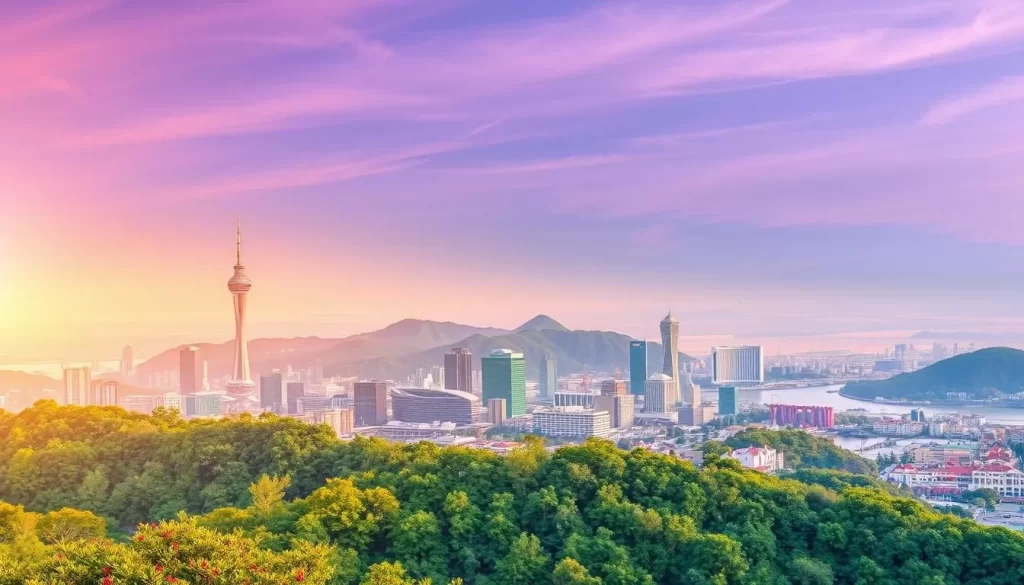
Best Time to Visit
For comfortable weather, April, May, September, and October are the best time visit. These months offer mild temperatures and minimal rain, making them ideal for exploring.
If you enjoy winter activities, January and February are perfect for snowy adventures. However, avoid July and August if you’re not a fan of heat and humidity.
Notable Events and Holidays
Spring brings cherry blossom festivals in April, while autumn celebrates Chuseok in September. Winter offers festive Christmas markets in December. Plan your trip around these events to experience the local culture at its finest.
“Timing your visit based on monthly weather ensures you enjoy the region at its best.”
Tips for Selecting the Right Month
- Prefer mild weather? Visit in April, May, September, or October.
- Love winter sports? January and February are ideal.
- Avoid July and August if you’re sensitive to heat and humidity.
Travel Planning: Timing Your Visit for Optimal Weather
Choosing the right time to visit can make or break your travel experience. Each season offers unique advantages and challenges, so understanding what to expect helps you plan better. Whether you’re drawn to outdoor adventures or cultural events, timing your trip well ensures you enjoy the best of what the region has to offer.
Comparing Seasonal Pros and Cons
Spring and autumn are widely regarded as the best time year to explore. With mild temperatures and stunning scenery, these seasons are perfect for outdoor activities. Spring brings blooming cherry blossoms, while autumn offers colorful foliage and cultural festivals.
Summer, on the other hand, can be hot and humid, with temperatures soaring up to 35°C (95°F). Monsoon rains peak in July, making it less ideal for outdoor plans. Winter is cold, with temperatures dropping to -5°C (23°F), but it’s great for snowy adventures and cozy indoor activities.
Here’s a quick comparison of the seasons:
- Spring: Mild weather, blooming scenery, and fewer crowds.
- Summer: Hot and humid, but vibrant cultural events.
- Autumn: Crisp air, colorful landscapes, and fewer rainy days.
- Winter: Cold and snowy, ideal for winter sports and cozy retreats.
For a balanced travel experience, consider visiting during shoulder seasons like spring or autumn. These months offer comfortable weather and fewer crowds, making them the best time visit for most travelers.
If you’re planning a trip, explore the do in the to make the most of your visit. Whether you’re hiking in spring or enjoying winter sports, timing your trip ensures a memorable adventure.
Essential Packing Tips for Daegu’s Changing Climate
Preparing for your trip means packing smart for the region’s unpredictable weather. With four distinct seasons, you’ll need to plan for everything from sunny days to sudden rain showers. Here’s how to pack efficiently for any scenario.
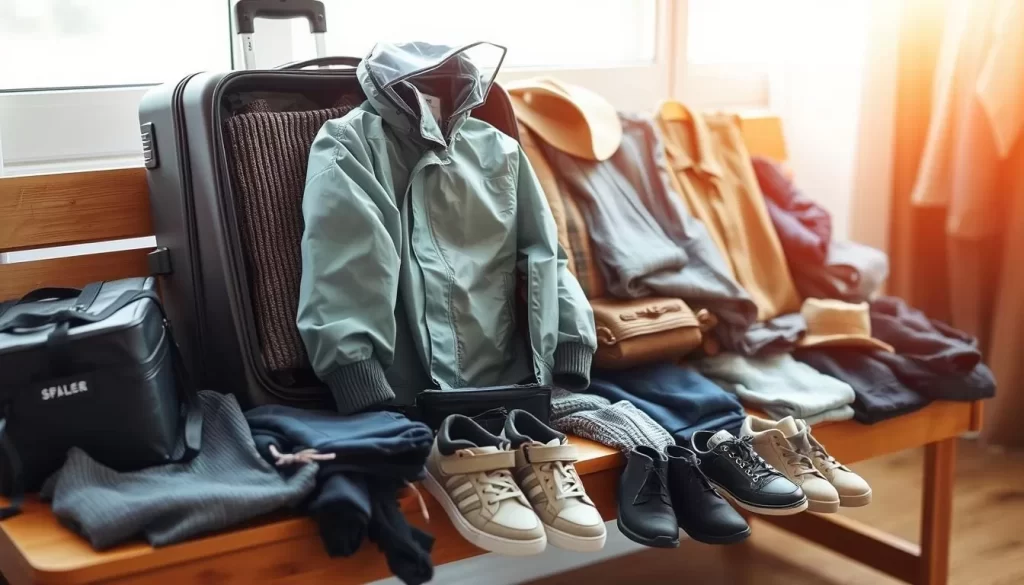
Packing for Variable Weather Conditions
Layering is your best friend when dealing with fluctuating temperatures. Start with lightweight, breathable fabrics for spring and autumn, when temperatures range from 59 to 70 degrees F (15 to 21 degrees C). Add a waterproof jacket for unexpected rain, which occurs on about 20% of spring days.
For summer, pack moisture-wicking clothing to combat humidity levels exceeding 80%. Winter requires thermal wear, as temperatures can drop to -5°C (23°F). Don’t forget sturdy boots for snowy or wet conditions.
Must-Have Accessories for Comfort
Accessories can make or break your trip. A compact umbrella or raincoat is essential during the monsoon season, which peaks in July. Sunscreen and a wide-brimmed hat protect against strong sun rays, especially in summer.
Hand warmers and a scarf are lifesavers in winter, while a portable fan helps during humid days. Comfortable footwear is a must for exploring, whether you’re hiking or strolling through the city.
Here’s a quick checklist to ensure you’re prepared:
- Lightweight layers for spring and autumn.
- Waterproof gear for rainy days.
- Thermal wear and boots for winter.
- Sunscreen and a hat for sun protection.
- Portable fan for summer humidity.
By packing smart, you’ll stay comfortable and ready for any adventure. For more insights on navigating the region’s climate, explore resources on foreign direct investment and its impact on local infrastructure.
Experience Local Culture: Events and Festivals in Daegu
Immerse yourself in the vibrant culture of this region through its unique events and festivals. From traditional holidays to modern celebrations, there’s always something happening to captivate visitors. These gatherings offer a glimpse into the heart of local life, making your trip unforgettable.
Key Holidays and Celebrations to Note
One of the most significant holidays is Chuseok, a harvest festival celebrated in autumn. Families gather to honor ancestors, share meals, and participate in traditional games. This event is a must-see for anyone looking to experience authentic local traditions.
Spring brings the cherry blossom season, marked by festivals that attract tourists from all over. These events feature stunning floral displays, live performances, and food stalls. It’s a perfect time to enjoy the beauty of nature while celebrating local culture.
Other notable events include the Busan International Film Festival in autumn and the Boryeong Mud Festival in summer. These gatherings highlight the region’s artistic and adventurous spirit.
Insider Tips for Authentic Local Experiences
To truly connect with the culture, participate in community activities. Join a traditional tea ceremony or try your hand at making local crafts. These hands-on experiences offer a deeper understanding of the region’s heritage.
For a more relaxed vibe, explore local markets. Here, you’ll find handmade goods, seasonal treats, and friendly vendors eager to share their stories. It’s a great way to support local artisans while enjoying unique souvenirs.
Timing your visit during festivals can enhance your trip, but be prepared for crowds. Arrive early to secure a good spot and take advantage of quieter moments to explore.
“Festivals are the heartbeat of a community, offering a window into its soul. Don’t just watch—participate and make memories.”
| Event | Season | Highlights |
|---|---|---|
| Chuseok | Autumn | Family gatherings, traditional games |
| Cherry Blossom Festivals | Spring | Floral displays, live performances |
| Busan International Film Festival | Autumn | Film screenings, celebrity appearances |
| Boryeong Mud Festival | Summer | Mud activities, live music |
For more insights on planning your visit, check out this guide on the the region’s cultural highlights.
Seasonal Activities: From Hiking to Skiing in Daegu
Exploring the outdoors in this region offers something for every season. Whether you’re an adrenaline junkie or a family looking for fun, there’s an activity to match your interests. The changing weather creates unique opportunities for adventure all year round.
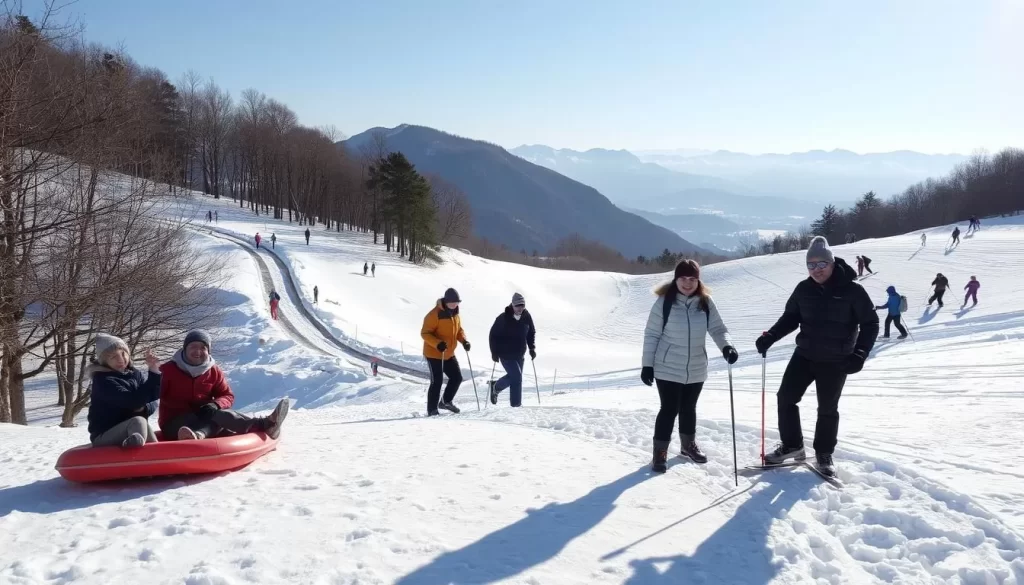
Outdoor Adventures Across the Seasons
Spring is perfect for hiking, with mild temperatures ranging from 59 to 65°F (15 to 18°C). Trails like Apsan Park and Palgongsan Mountain are popular for their scenic views and blooming flowers. Summer brings water sports and cultural events, though the heat can reach up to 86°F (30°C).
Autumn is ideal for gentle hikes and enjoying colorful foliage. Temperatures hover around 66 to 70°F (19 to 21°C), making it comfortable for all-day outings. Winter transforms the region into a snowy playground, with opportunities for skiing and snowboarding. Nearby resorts offer slopes for all skill levels.
Family-Friendly Experiences All Year Round
Families can enjoy city tours in spring, exploring cultural landmarks and parks. Autumn is great for picnics and nature walks, while winter offers sledding and ice skating. Summer’s festivals provide entertainment for all ages, even if the heat encourages indoor breaks.
Here are some seasonal highlights:
- Spring: Cherry blossom festivals and scenic hikes.
- Summer: Water sports and vibrant cultural events.
- Autumn: Foliage tours and family picnics.
- Winter: Skiing, snowboarding, and cozy indoor activities.
| Season | Activity | Best Locations |
|---|---|---|
| Spring | Hiking, festivals | Apsan Park, Palgongsan Mountain |
| Summer | Water sports, festivals | Local rivers, cultural centers |
| Autumn | Hiking, picnics | Duryu Park, scenic trails |
| Winter | Skiing, ice skating | Nearby resorts, local rinks |
No matter the season, there’s always a way to enjoy the great outdoors. Plan your day around the weather, and you’ll create unforgettable memories.
Optimizing Your Itinerary: Where and When to Visit
Crafting the perfect itinerary ensures you make the most of your trip. By balancing historical visits, outdoor adventures, and festival experiences, you can enjoy the city’s diverse charms. Whether you’re exploring for a day or a month, thoughtful planning enhances your travel experience.
Creating a Balanced Travel Schedule
Start by dividing your time between cultural landmarks, natural attractions, and local events. For example, spend mornings exploring historical sites and afternoons enjoying outdoor activities. This approach ensures you experience the city’s highlights without feeling rushed.
Include restful breaks in your schedule. After a busy day of sightseeing, take time to relax at a local café or park. This balance keeps your energy levels high and allows you to fully enjoy each activity.
Adjusting for Weather and Flexibility
Weather can be unpredictable, so build flexibility into your plans. If rain interrupts your outdoor activities, switch to indoor attractions like museums or markets. This adaptability ensures you make the most of your time visit, no matter the conditions.
For a seamless experience, consider visiting during shoulder seasons like spring or autumn. These months offer mild weather and fewer crowds, making them the best time to explore.
Exploring Hidden Gems and Popular Spots
While popular attractions are a must-see, don’t overlook hidden gems. Local markets, quiet parks, and lesser-known landmarks offer unique insights into the city’s culture. Allocate time to discover these treasures for a well-rounded experience.
For more tips on planning your trip, check out this guide on relocating and exploring the region. With a balanced itinerary, you’ll create unforgettable memories year round.
Conclusion
Timing your visit with the right season ensures a memorable and stress-free adventure. Whether you’re drawn to mild spring blooms or crisp autumn foliage, understanding the weather patterns helps you make the most of your trip.
Pack smart by layering for spring and autumn, and include waterproof gear for summer rains. Winter calls for thermal wear and sturdy boots to stay cozy during snowy adventures. A well-planned itinerary balances outdoor activities with indoor cultural experiences, ensuring you’re prepared for any condition.
Exploring this region offers something for every time of year. From hiking in spring to skiing in winter, each season brings unique opportunities. For more tips on planning your trip, check out this travel guide to make the most of your visit.
The above is subject to change.
Check back often to TRAVEL.COM for the latest travel tips and deals.
Here are some Tours & Sightseeing suggestions that might pique your interests!
